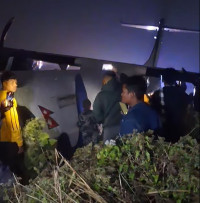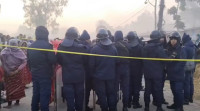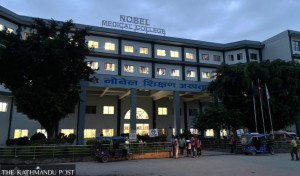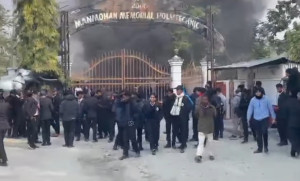Koshi Province
Tihar joy fades for families hit by floods and landslides
In Panchthar district, September floods and landslides killed 11, left four missing, and destroyed hundreds of homes.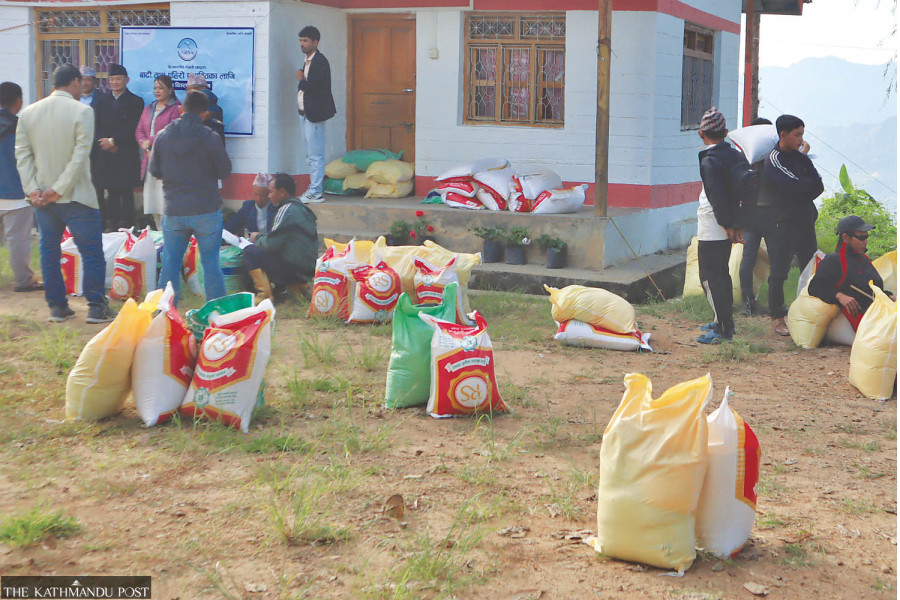
Laxmi Gautam
Mani Kumar Rai, a permanent resident of ward 2 of Phidim Municipality in Panchthar district, had a painful memory of Tihar—the second major Hindu festival after Dashain. He did not celebrate Tihar. The festival of light and flowers passed on a sad note for him this year. His younger sister perished in a landslide triggered by heavy rains on September 12.
“My sister died soon before Dashain. My nephew, who survived the disaster, is still receiving treatment. My sister’s memory returned fresh in Tihar. I spent the entire festival in tears,” said Mani, who is in his early fifties. “Tihar reminded me of the tragic incident again. The disaster ruined our festival.”
In Hindu culture, sisters offer Tika to their brothers and pray for their long, happy and prosperous lives. The rain-induced disasters on September 27 and 28 ruined the festive spirit of hundreds of families across the nation.
Ganga Bahadur Shrestha of ward 3 of Phidim used to celebrate Tihar with much fanfare each year. His sisters and daughters came to their parental home during Tihar. There used to be a sort of race to decorate the houses, clean the surroundings and make garlands. Siblings, cousins, nephews and nieces gathered at his home for Bhai Tika.
But the wheel of fate took a sharp turn for Ganga Bahadur this year. The floods and landslides caused by heavy rains stole his happiness. The landslide destroyed his house and farmland. “My sisters and daughters would have visited my house if it was not destroyed. The floods and landslides swept away our home, stored grains, animals, and crops. This year’s Dashain and Tihar were filled with worry and sorrow,” lamented Ganga Bahadur.
Not only Mani and Ganga Bahadur, but hundreds of the families of floods and landslides victims in Panchthar, a hill district in Koshi Province, did not celebrate Dashain and Tihar. Many lost family members, relatives, homes, or farmland. The survivors are still taking shelter in neighbour’s houses, community buildings, tents or poorly-built huts.
According to the district disaster management committee in Panchthar, 11 people were killed by the floods and landslides in the district while four others are still missing. Six people, including Mani’s nephew, were injured in the calamities. As many as 300 houses were completely destroyed by the floods and landslides in Panchthar while 221 others were partially damaged.
Phidim Municipality, Phalgunanda and Phalelung rural municipalities were greatly affected by the rain-induced disasters. The displaced people have been left in the lurch and facing shortage of essential commodities for their survival.
Most of the displaced families have not yet returned to their houses even after five weeks since the disasters. They lost their houses, cultivable lands, domesticated animals, and ready to harvest crops in the disasters. Now, they are worried about how they will rebuild their ravaged homes and manage food for their livelihood.
“We got some relief materials provided by the local units and some organisations. But how are we supposed to manage our livelihood? How can we rebuild our home?” said Bishnu Angbo of Phalelung-5. His house was swept away by a landslide in September last week.
The displaced people are quite worried about the approaching winter. “We have been displaced for five weeks. The government authorities seem indifferent to our rehabilitation. Cold winter days loom in the hill settlements. How can we protect ourselves from the biting cold?” said a landslide victim from ward 5 of Phalelung.
Victims of the floods and landslides express their ire with the government and authorities concerned for their lackadaisical response to the rehabilitation of the displaced people. According to Chief District Office of Panchthar Bishnu Koirala, the authorities are assessing the damage caused by the disasters. “We will soon write to the National Disaster Risk Reduction and Management Authority about the total damage and work for the reconstruction of the damaged structures and rehabilitation of the displaced people,” said Koirala.
The floods and landslides triggered by incessant rains in September last week wreaked havoc in various parts of the country. The Bagmati and Koshi provinces were the hardest hit by the floods and landslides.
The government declared 70 local units in 20 most affected districts as ‘disaster crisis zones’ with the objectives of expediting rehabilitation, recovery and reconstruction efforts. However, the relief and rehabilitation works have not been carried out effectively, leaving hundreds of displaced families to fend for themselves.




 6.73°C Kathmandu
6.73°C Kathmandu
